

Though sympathetic to the Axis cause, Franco resisted Hitler’s advances to bring Spain formally into the war even at the height of the Third Reich conquests. Spain had just suffered through a lengthy civil war which had drained its resources, and was therefore in no position to assist in any significant matter. Franco did allow, however, volunteers to serve under German arms on the Eastern front; by doing this he maintained Spain’s neutrality while both repaying the help Germany provided during the Spanish Civil War and continuing his fight against Bolshevism. Within minutes of Germanys invasion of the Soviet Union, Von Ribbentrop received a formal offer of aid and on June 24 1941, Hitler approved the use of Spanish volunteers.
In Spain, there was no shortage of volunteers and though only 4,000 men were initially required, the overwhelming response prompted the authorities to set the goal of a full division, which in the Spanish Army equaled 19,000 men. Volunteer regiments were raised in Madrid, Barcelona, Seville, Valencia and all other metropolitan areas. On July 2nd, 1941 the recruiting stations were officially closed, with the number of even a full division having been surpassed. The men who lined up at the party offices and Army barracks were not raw recruits, most were Civil War veteran thoroughly familiar with the rigors of military life.
The Spanish “Blue Division”
With the Legion now forming, the commander of the Spanish was announced; it would be General Augustin Muñoz Grandes. The issue of uniforms was complicated because Spanish was not technically at war so Spanish Army uniforms were out of the question. A new symbolic uniform was created which consisted of the red beret of the Carlist movement, the blue shirt of the Falangist movement (from which the division received its name) and the khaki trousers of the Spanish Foreign Legion, while Officers wore khaki shirts with blue cuffs and collar. This uniform was worn on leave in Spain, but before going to the front the Legionnaires would change into regular field gray Heer uniform with a shield on the upper right sleeve which bore the Spanish National colors with the word “España”.
On July 13th the first train with volunteers left Madrid bound for Grafenwohr, Bavaria, where they became the Wehrmacht 250th Infantry Division with a strength of 17,924 Officers and men in four infantry regiments. As German divisions had three regiments, one of them was soon dispersed among the others leaving the 262nd (mainly Barcelona recruits), 263rd (Valencia) and 269th (Seville) regiments. Each regiment had three battalions of four companies. An artillery regiment (the 250th) consisting of three batteries of 150mm guns and one of 150mm guns was added to the division. Also, because among the volunteers there were enough pilots, a squadron was formed entirely of Spanish airmen and equipped with Me 109s and later FW 190s. The “Blue Squadron” received credit for 156 Soviet aircraft.
After undergoing a five-week training period in Grafenwohr, the division took an oath in front of Hitler and left for the front on August 20, 1941. After embarking on long marches (totaling 1,000km) to reach the front at Smolensk where they were supposed to join army group center on the attack on Moscow, they were rerouted north to Leningrad where they formed part of the German 16th army. On October 10, 1941, the Spanish Legion saw its first action in the sector between Ilmen and the west bank of the Volkhov river and participated in a major offensive against Leningrad which took place four days later. They were to remain on the siege of Leningrad for the remainder of the division’s life, where they fought with distinction (in December 1942, General Emilio Esteban Infantes took command of the division).
The ruthless winters and savage fighting inflicted heavy casualties among the Legion, so much so that there were rumors that the entire division was going to collapse. Reinforcements were quickly organized in Madrid and sent to the front, as it was not the fate of a single division but the honor and reputation of Spain that was at stake. In order to keep up the numbers, conscripts were sent in along with volunteers. Because of casualties, and a system of rotation, as many as 45,000 Spaniards fought on the Eastern front. Of these, 4,500 were killed in action and a 16,000 further were taken prisoner or wounded in action. Those who were wounded were treated on hospitals throughout Germany, which were operated mainly by Spanish Medical Staff.
|
General Augustin Muñoz Grandes, leader of the Blue Division, shares a laugh with Luftwaffe personnel. |
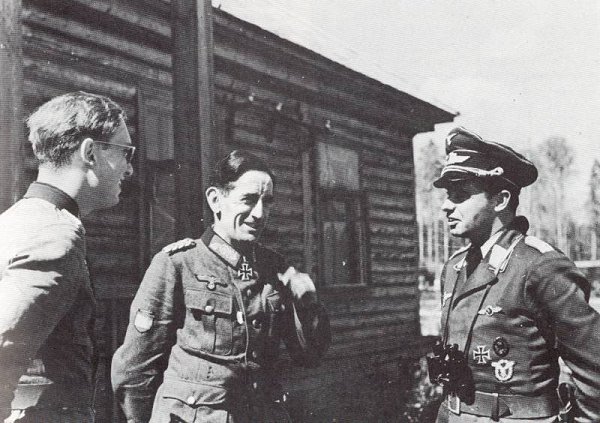 |
As the fortunes of war began to turn against the Axis, the Allies began to place considerable pressure on Franco to recall his fighting force. Negotiations with the German government began in the Spring of 1943, and the order to withdraw was given on October 10th, 1943. A “Blue Legion” compromising 3,000 men was left behind, commanded by Colonel Navaro, and it was attached to 121st infantry Division. This appeased the Germans and those volunteers who did not want to abandon the struggle, but even this token force was ordered to withdraw in March, 1944.
Though it was now illegal for Spaniards to serve on the Axis side, some of the volunteers refused to return. Partly refreshed by fresh forces they smuggled across the border to Lourdes, France, where they were picked up by a especial unit and sent mainly to the Waffen SS. However, there were also platoon sized units attached to the 3rd Mountain Division and the 357th Infantry Division. A further two companies of Spaniards were sent to the Brandenburg unit for anti-Partisan action in Yugoslavia. One of these Brandenburg companies was sent in September of 1944 to Austria, where it became the Spanische-Freiwilligen-Kompanie der SS 101 and soon afterwards a second company (102) was formed. The 101 Company was attached to the 28th Waffen SS Division (Wallonien) and saw heavy action in Pomerania. In the end, the 101st was attached to the 11th SS Division Nordland and fought to the bitter end in the defense of Berlin. Waffen Haupsturmfuhrer der-SS Miguel Ezquerra commanded the 101st in the last days of Berlin. He survived the battle, and later escaped from Russian imprisonment to return to Spain.
An honest assessment of the Spanish Volunteers would cast them in a favorable light,
their fierce fighting abilities places them among the most successful
foreign legions who fought for the Third Reich. They proved themselves in battle
continuously in one of the most brutal theaters of war in history, the Eastern
Front.
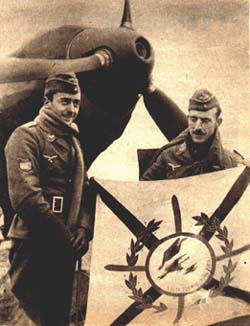 |
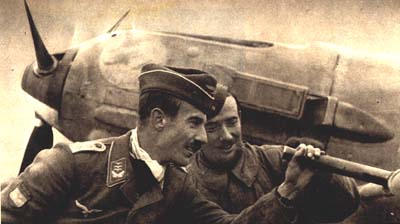
|
Right, Blue Squadron pilots display their flag which reads "Vista, Suerte y al Toro". Above, inspecting a Bf 109, notice the "España" patch on the right arm. |
Spanish Volunteer Medal (German Government Issued)
The award presented to the legions was the “Erinnerungsmedaille für die Spanischen Freiwilligen’ im Kampf gegen den Bolschewismus”, or “Commemorative Medal for Spanish Volunteers in the Struggle against Bolshevism.. Known as the “Blue Division Medal”, it was instituted on January 3rd 1944 to recognize the 250th Infantry Division.
The “Blue Division Medal” was die struck in zinc alloy with a bronze wash. It was produced by the Deschler und Sohn firm, and measured 32mm in diameter and 1mm in width.
It featured on the bottom obverse a swastika with a spray of laurel leaves emanating from each side, with the leaves arranged differently on both ends. A Military sword crossed the center, with two shields superimposed on it. These shields were flat toped with a pointed bottom, on the left one was the Wehrmacht eagle while the other featured the Falangists crushed arrows. Directly above the shields was an M-43 German helmet facing left, with the faint outline of the Wehrmacht Eagle on it.
The reverse bottom had an Iron Cross, with the ribbon spread above it intertwined with a spread of leaves on both sides. On the left, these were laurels while on the right they were oak leaves. In the center, the medal bore the inscription DIVISION ESPANOLA DE VOLUNTARIOS EN RUSIA” (Division of Spanish Volunteers in Russia) in capital letters. On top of the medal was the ribbon ring, through which a ribbon loop was placed which was normally stamped with the number “1”. The ribbon was 30mm wide, with a 4mm black edge, a 2mm white stripe and an 18mm red center band with a 3mm yellow stripe on this red.
The medal was presented on a maroon box with paper hinge or in an envelope in which the entire name of the award was written in gothic script. In both cases the award was wrapped in tissue paper.
It is interesting to note that Franco allowed the wear of Nazi Germany awards
in their original form after the war and therefore the “Blue Division” medal was
officially produced in Spain as a replacement piece for veterans. Because their wear was officially sanctioned, these are
not considered reproductions, although they are not as desirable to collectors.
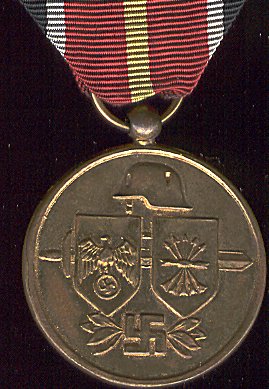 |
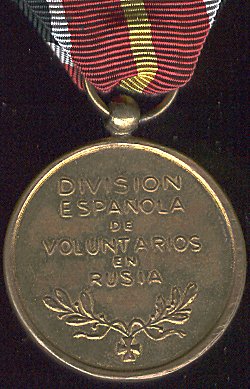 |
Spanish Volunteer Medal (Spanish Government Issued)
The Spanish Government presented the Division with a commemorative medal of its own. This award was surmounted by a Spanish Crown, with its main feature being a Spanish Eagle with an enamel Iron Cross in the center, representative of the collaboration between the nations. The reverse featured the Kremlin and the inscription “Rusia 1941”, denoting that the struggle was in the East. It was held by a white ribbon that had on either side with the national colors of Spain and the Third Reich.
The medal was presented to all Spanish Volunteers who fought against bolshevism in Russia. Because the swastika was not outlawed in Spain following the war, veterans continued to wear their awards as originally designed. This meant that there was a market for replacements, so this medal was in production after the end of the war. They may be discerned from one another by the fact that as the initial production run had a space between the talons of eagle, while the later produced ones did not. These later awards, however, are not considered reproductions as the Spanish Government officially sanctioned them.
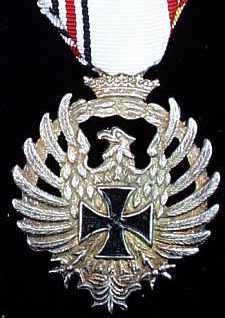 |
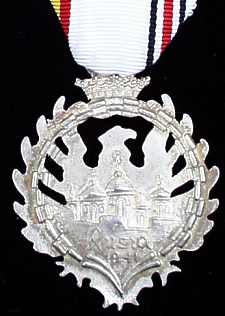 |
German Awards Presented to Spanish Volunteers
While serving with their Allies, Spanish soldiers were awarded many German decorations (General Augustin Muñoz Grandes was presented the Knights Cross for his services). Legionnaires were also eligible for the Campaign in the East award, as evidenced by the award document below..
To return to the section you came from click on the appropriate icon below.
| Service Awards | Axis Allies |
| Main Page | Iron Cross | German Cross | War Merit Cross | Wound Badges | War Badges |
| Campaign Awards | Service Awards | Honor Awards | Axis Allies | Collectors Corner | Online Forum |